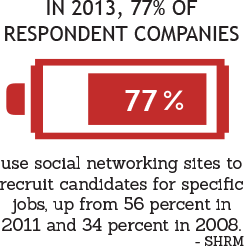Social media might not seem integral to recruiting to the uninitiated, but it is pretty much the norm in terms of a legitimate hiring process. Use social media platforms to post jobs, search for candidates, and generate employee referrals. Continue reading to see pitfalls you should look out for, and methods to success when social recruiting.
HOW TO USE SOCIAL MEDIA FOR RECRUITING

Internal recruiters and external recruitment agencies are facing similar challenges when it comes to hiring skilled workers. These challenges primarily revolve around the amount of competition for skilled candidates and the number of online hiring platforms of which candidates are exposed. The abundance of online hiring platforms, such as Indeed, Monster, Career Builder, etc. forces recruitment officers to use multiple avenues in an effort to find the right candidate. One of the less cluttered platforms is social media recruiting. If used effectively, then social platforms like LinkedIn, Facebook, Twitter, and more can be leveraged by companies to reach unique candidates and highlight their company’s work culture.

It might be easier to use social media for recruiting than you think. Some of the most common uses are to:
- Post jobs
- Search for candidates
- Contact candidates
- Display your employer brand
- Keep track of potential candidates
- Vet candidates pre-interview
- Vet candidates post-interview
- Generate employee referrals
LEGAL RISKS OF SOCIAL RECRUITING
Hiring and recruiting managers need to be wary of using social media to recruit exclusively because it can be used the wrong way – a way that could expose your organization to risk.
Here are two problematic scenarios you could run into using social media to recruit:
- If screening a candidate through social media disqualified them because of “protected class information,” you could be sued. Protected class information is age, race, gender, religion, etc.
- Not everyone has access to technology in order to use social media, which could exclude certain groups of people from participating altogether.

Using social media to recruit is commonplace now. Hiring and recruiting managers should be using it appropriately to attract and screen talent. Here are a few things to think about to help you avoid problems:
-
- Social media shouldn’t be used to make a final employment decision. Social recruiting is a way to diversify recruiting and hiring strategies, not to replace it. Social media recruiting should be used to gain a deeper understanding of candidates.
- It might be wise to only use social after you’ve met a candidate in person to lessen the likelihood of it making a quick judgment
- While you legally don’t have to let candidates know you may review their public social media accounts – you should decide how or if your company wants to give them fair notice.
- If you do it for one, do it for all. Evaluate all candidates the same way. Use HR to help you navigate recruiting if they will be less biased and know what to look for – what might raise a red flag or might not be a big deal.
- Document! Document! Document! If a hiring decision is made in part due to a candidate’s social media content, ensure all those documents/posts/etc. are kept in case a decision is challenged.

BEST PRACTICES FOR SOCIAL RECRUITING
- Use social media to recruit passive candidates. Passive candidates are people that have jobs but are not actively searching for new employment.
- Social media recruitment can be used to see a candidate’s positive attributes, such as volunteer work.
- Let the candidate come to you. Highlighting your company’s corporate culture, working environment, and community engagement can set your company apart from the competition.
- Good social recruiting might help you find and court talent, but an effective onboarding strategy, good benefits and compensation, and a welcoming company culture is ultimately what makes employees want to stay with your organization.